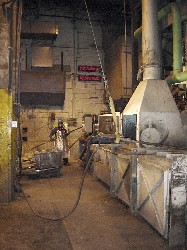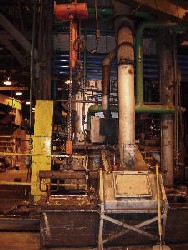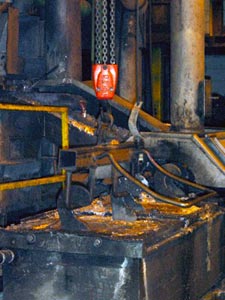Lead: Secondary Lead Smelter eTool
Smelting » Blast Furnace
Blast furnaces are designed and operated to produce a hard (high alloy content) lead product. Blast furnaces emit high levels of lead fume during the the following processes:
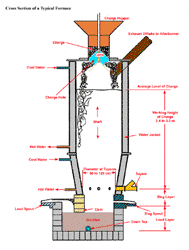
Potential Sources of Exposure
-
Spillage or emissions may occur at blast furnace feed conveyor transfer points and charging points.
-
Spillage of lead-containing dust may occur if bucket elevators, conveyors, or skip hoists are overfilled.
-
Lead fume and dust may be emitted from the blast furnace if the charge level is too low.
Possible Engineering and Work Practice Controls
-
Maintain raw material storage and handling areas under negative pressure to prevent contamination of adjacent work areas.
-
Prevent puffing by providing and maintaining process controls to ensure that the proper amount of charge material is in the thimble on the top of the furnace.
-
Provide hooding with sufficient exhaust ventilation at furnace feed conveyor loading and charge points to capture dusts and fumes which may be emitted.
-
Provide hooding with sufficient exhaust ventilation to capture dusts which may be generated when charging the furnace.
-
Do not overfill bucket elevators, conveyors, or skip hoists.
-
Maintain positive-pressure, HEPA filtered air systems on mobile equipment to ensure effective operation. Check and change air filters regularly as part of an effective scheduled preventative maintenance program.
-
Vacuum any spills immediately with a HEPA filtered vacuum system. Water should not be used in the smelting area for dust suppression due to the possibility of oxide fires and the mixing of water and molten lead.

Blast furnace tapping operations involve removing the slag and then tapping molten lead from the furnace into molds or ladles. Some smelters tap metal directly into a holding kettle which keeps the metal molten for refining. The other smelters cast the furnace metal into blocks and allow the blocks to solidify.
Potential Sources of Exposure
-
Lead fumes may be emitted at the lead or slag tapping plugs during removal of the tapping plug or while lancing the tapping plug.
-
Emissions may occur while pouring lead or slag at the tapping launder, mold, ladle, or refining kettle.
-
Lead dust may become airborne due to disturbance of settled dust in the smelting area.
-
Emissions may occur from ladles containing slag or molten lead.
-
Spilled slag or molten lead may emit lead fumes.
Possible Engineering and Work Practice Controls:
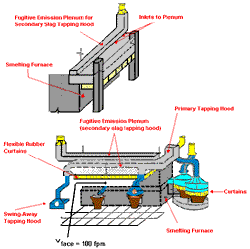
- Provide local exhaust ventilation at the lead and slag tap, launders, molds, ladles, and refining kettles.
- Allow lead and slag pots to remain under the exhaust hood until crusted to minimize fume emissions.
- Provide a supplied air island at lead and slag tapping stations.
- Provide local exhaust ventilation for staged slag pots if necessary.

Blast air for the combustion process enters the blast furnace through "tuyeres." The tuyeres occasionally begin to fill with accretions and must be physically punched, usually with a steel rod, to keep them unobstructed. The conventional method used for this task is to remove the cover of the tuyeres and insert the steel rod. After the accretions have been "punched," the cover is replaced.
Recently smelters have been able to adapt an "off-the-shelf" automatic tuyere puncher that has greatly reduced employee lead exposure. However, even with the automatic system there are occasions when the tuyere pipe has to be cleared by using a jackhammer or rod.
Potential Sources of Exposure
- Significant lead fume emissions may come from the furnace during manual punching.
Possible Engineering and Work Practice Controls

- Provide automatic tuyere punching.
- Use notched, rotating tuyere covers to minimize tuyere opening during punching.
- Stand to the side of the tuyere when opening the cover during the tuyere punching operation.
- Provide a rod of sufficient length to minimize operator exposure.
- Provide a viewing port on the tuyere cover so that plugging can be observed without removing the cover.




